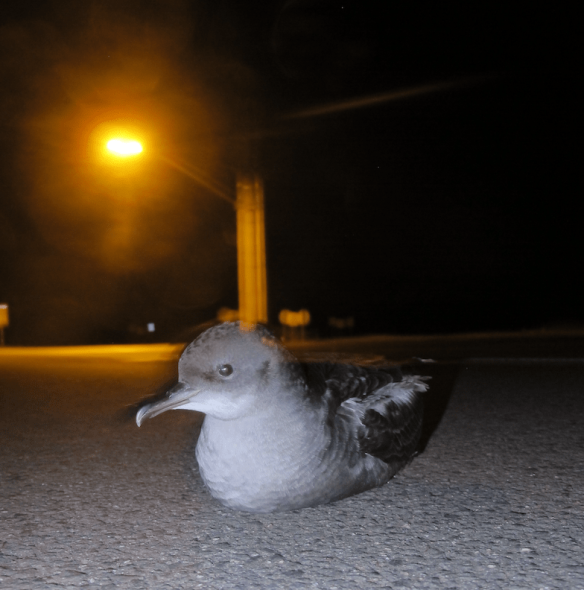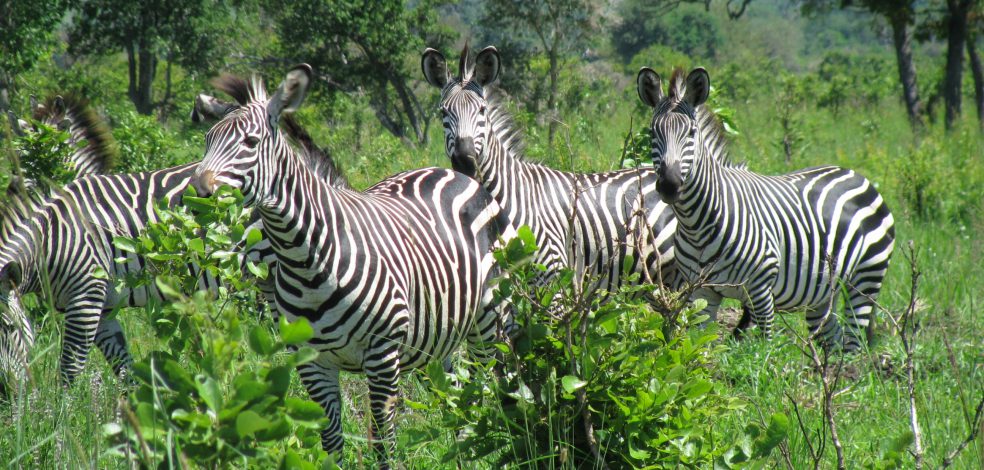In late October, the municipality of Buenavista del Norte on the Canary Island of Tenerife, celebrates the day of the Virgin of Los Remedios, including, among other features, a big light display. As a child, Airam Rodríguez noticed that many shearwaters would also drop in (literally) for the festivities, attracted by the bright lights, but unable, in many cases, to get back in the air. Many of these shearwaters died from a variety of causes, including the impact of flying into the ground, dehydration, predation and poaching. As an adult, Rodríguez collaborated with researchers around the world to evaluate the scope of light-induced shorebird fallout.

Fallout victim: grounded Short-tailed Shearwater. Credit: Airam Rodríguez
The researchers began their work by searching a science citation index – the Web of Science – for articles on light-induced seabird mortality. They used references from these articles to find additional articles. In addition, they used the internet and social media to find programs in which citizens are encouraged to report grounded birds, and contacted people associated with these programs to get qualitative and quantitative data.
Rodríguez and his colleagues discovered light induced seabird fatality on 47 islands, three continental locations and across all of the world’s oceans. Of 115 species of burrow-nesting petrels, 56 have been reported as grounded by light. Several other groups of birds, including puffins, auklet and eiders also suffer from light-induced fallout, and it is very likely that more species are unreported.

Numbers of reported grounded seabird fledglings across the globe. Circle size = numbers of birds reported. Numbers = number of species affected. Circle color = IUCN (endangerment) category for each species as follows: CR = critically endangered, EN = endangered, VU = vulnerable, NT = near threatened, LC = least concern.
Of deep concern is that 24 species are globally threatened. In addition, fallout has been reported at sea, induced by lights used for fisheries and by lights on oil platforms. All of the studies of light-induced fatalities on land documented the highest mortality in fledglings that are grounded during their first flights from their nests toward the ocean.

Numbers of species of threatened seabirds that were rescued across the globe. Numbers were not available for species with ? symbol.
Researchers don’t know why birds are attracted to lights. Perhaps birds view lights as a source of food; for example some species eat bioluminescent prey. Alternatively, as cavity-nesting birds, the only light these chicks see is from their burrow entrance, particularly when their parents bring in food, so the fledglings might confuse light with a food source. Lastly, artificial lights might override any celestial light cues the birds normally use for navigation, confusing them and causing them to crash to the ground. Supporting this hypothesis, seabirds generally don’t crash into lights, which might be expected if they mistook a light for bioluminescent prey.

Fledgling Cory’s Shearwater first sees the light of day after emerging from its burrow at Arona on southern Tenerife Island. Credit: Beneharo Rodríguez
So what can be done about this problem? Accurate data are hard to come by, as many estimates of fallout-induced mortality come from relatively untrained volunteers, who are less likely to report dead birds. As one example, on Kauai, surveys from a general public rescue program for Newell’s Shearwaters identified 7.7% mortality, whereas later systematic surveys by trained researchers indicated 43% mortality. In some rescue operations, birds are banded and released, which, in theory, allows researchers to estimate the survival rate of rescue birds, but, in practice, these data are usually insufficient for accurate estimates
Rodríguez and his colleagues recommend a multipronged approach to combat seabird fallout. Individuals grounded by artificial lights can be rescued so they don’t succumb to the common causes of death – dehydration, predation and vehicle collision. In many cases the general public takes birds to designated rescue stations, where they are cared for until judged to be ready to release. The first rescue program was set up on Kauai in 1978; since then, people working for 16 rescue programs have released over 40,000 birds.

Beneharo Rodríguez releases a Cory’s Shearwater from a cliff at Buenavista del Norte on Tenerife Island. Credit: Nazaret Carrasco.
The birds would be best served if humans behaved in ways that minimized fallout. Researchers need to learn more about why birds are attracted to artificial lights so engineers can develop outside lights that don’t attract them. Existing lights can be turned off when not needed, and dimmed when they are essential. Special accommodation can be made for unusual cases; for example in Cilaos, Reunion, Indian Ocean, streetlights are turned off during the fledging period of Barau’s Petrel. Lights can also be shielded so they illuminate an area for humans, but minimize the light visible to birds. Degraded nesting and breeding habitat can be restored to help compensate for birds that are lost to fallout. Lastly, conservation efforts should benefit the local economies so that residents will be more likely to support conservation initiatives, such as reduced evening lighting, that they might otherwise oppose.

That’s really fascinating Fred. I’ve been reading about the need for dark sky parks in Virginia, I know it’s not quite the same as this, but we really do have too much artificial light.
LikeLike
It’s amazing how many large birds we are killing with our contrivances. The “tilting at windmills” blog talks about this as well, and as always, these contrivances (windmills and lights and other things that kill birds) are pretty useful, so there is no clear answer about how to deal with them.
LikeLike